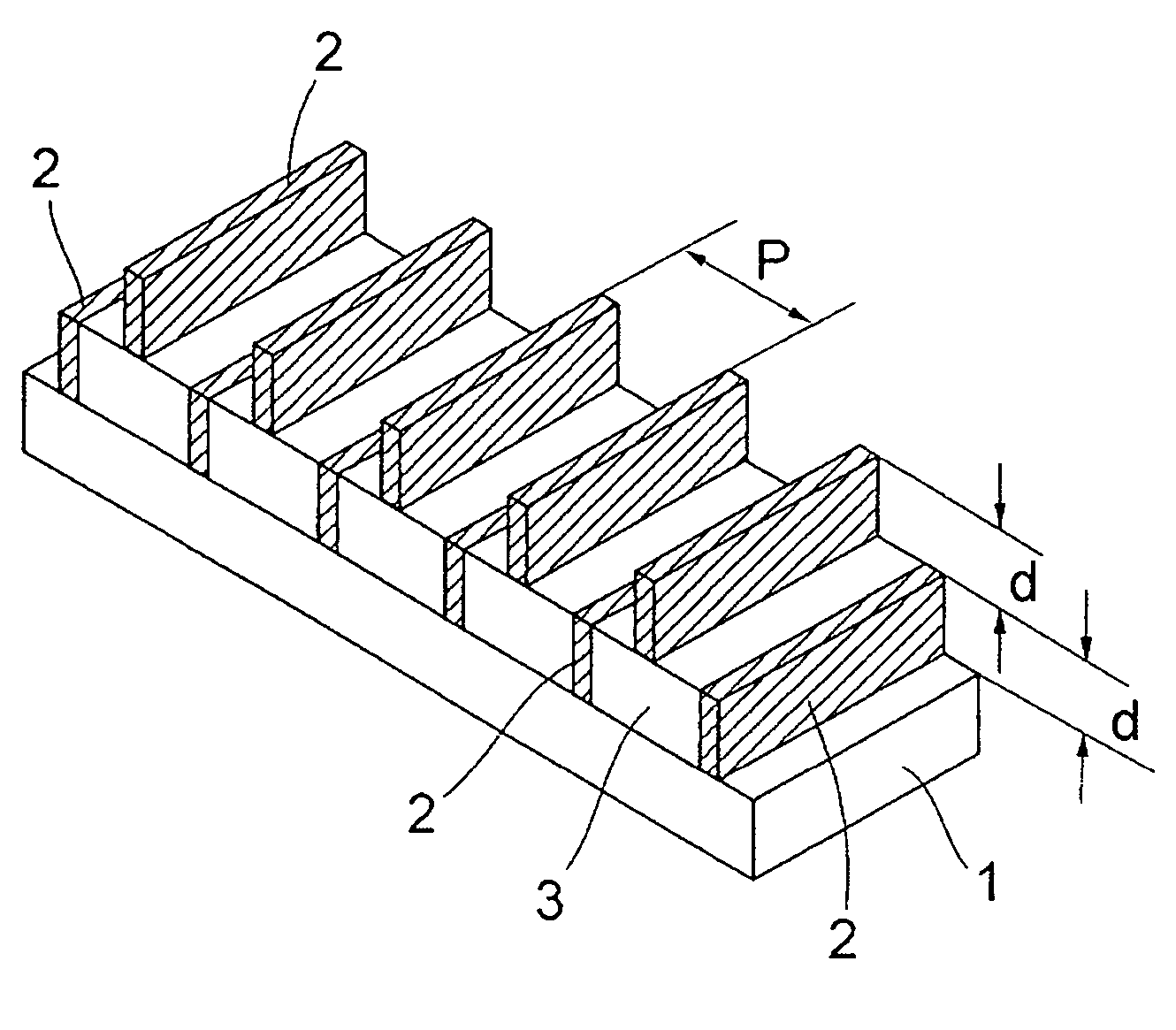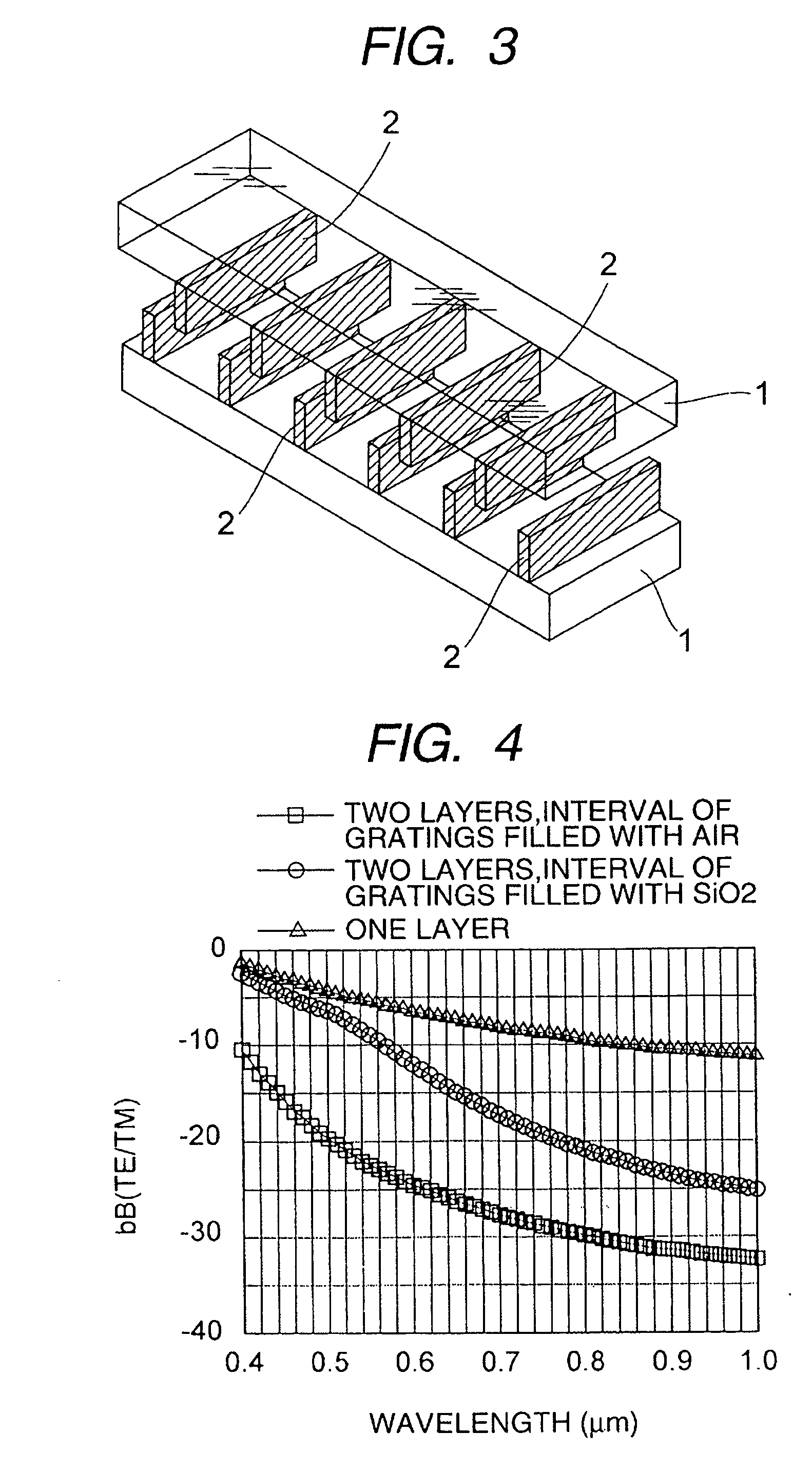Optical element, method of manufacturing same, and optical apparatus using optical element
- Summary
- Abstract
- Description
- Claims
- Application Information
AI Technical Summary
Benefits of technology
Problems solved by technology
Method used
Image
Examples
embodiment 1
[0022]FIG. 1 shows the construction of a fine optical element according to Embodiment 1.
[0023] Grating portions 2 made of a metal are arranged as a first layer at regular intervals on a substrate 1, a filling material 3 fills the space between adjacent ones of the grating portions 2.
[0024] Also, as a second layer, only grating portions 2 are likewise arranged at regular intervals on the filling material 3.
[0025] When the pitch P of the grating portions 2 of a height d on the substrate 1 is selected to a value smaller than the wavelength λ of light used, the grating portions 2 function as deflecting plates.
[0026] When the pitch P of the grating portions 2 is sufficiently smaller than the wavelength λ, the function as the deflecting plates becomes best. However, it is still difficult by the actual machining technique.
[0027] So, by stacking a structure comprising grating portions 2 of a great pitch P, nearly the best performance is obtained.
[0028] In FIG. 1, the grating portions ...
embodiment 2
[0035]FIG. 3 shows the construction of an optical element according to Embodiment 2, and this construction is one in which two transparent substrates 1 to which grating portions 2 are fixed at regular intervals are fixed with the grating portions 2 fixed in opposed relationship with one another.
[0036] The principle of this Embodiment 2 is basically the same as that of Embodiment 1. Also, unlike Embodiment 1, the space between adjacent ones of the grating portions 2 as the first layer is filled with air which is small in refractive index, to thereby improve the quenching ratio γ.
[0037] If here, the pitch P of the grating portions 2 is 0.26 μm, and the height d of the grating portions 2 is 0.15 μm, and a feeling factor f is 0.15, such characteristic of the quenching ratio γ as shown in FIG. 4 is obtained as the result of the simulation of RCWA.
[0038] In FIG. 4, points indicated by triangles represent the characteristic of the quenching ratio γ of a conventional grid wire deflecting...
embodiment 3
[0044]FIG. 5 shows the construction of an optical element according to Embodiment 3, in which on a substrate 1, there are arranged at regular intervals wall portions 4 provided with grating portions 2 on the uppermost portions thereof and having three kinds of heights.
[0045] Supporting portions 5 supporting the grating portions 2 are made of SiO2.
[0046] Also, the wall portions 4 having three different heights are arranged in the order of the heights, and combinations of three wall portions 4 repeatedly arranged.
[0047] The principle of this Embodiment 3 is also basically the same as that of Embodiment 1. The other portions than the SiO2 layers providing the supporting portions 5 under the grating portions 2 as the upper layer are air and therefore, the actual average refractive index becomes smaller than the refractive index of SiO2. Therefore, the quenching ratio γ of the stacked structures is improved.
[0048] Here, the pitch P of the grating portions 2 is 0.26 μm, the height d o...
PUM
 Login to View More
Login to View More Abstract
Description
Claims
Application Information
 Login to View More
Login to View More - R&D
- Intellectual Property
- Life Sciences
- Materials
- Tech Scout
- Unparalleled Data Quality
- Higher Quality Content
- 60% Fewer Hallucinations
Browse by: Latest US Patents, China's latest patents, Technical Efficacy Thesaurus, Application Domain, Technology Topic, Popular Technical Reports.
© 2025 PatSnap. All rights reserved.Legal|Privacy policy|Modern Slavery Act Transparency Statement|Sitemap|About US| Contact US: help@patsnap.com



